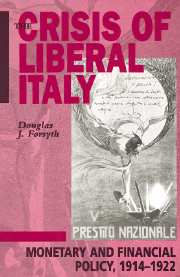Book contents
- Frontmatter
- Contents
- List of figures
- List of tables
- Acknowledgments
- Introduction
- Part 1 Giolittian Italy, 1901–1914
- Part 2 World War I, August 1914–November 1918
- Part 3 The post-war crisis, November 1918–October 1922
- 6 A difficult readjustment: the political economy of the Orlando and Nitti governments, November 1918–June 1920
- 7 From Giolitti to Mussolini: monetary and financial stabilization, and political collapse
- Conclusion
- Appendix: Tables and figures
- Bibliography
- Index
7 - From Giolitti to Mussolini: monetary and financial stabilization, and political collapse
Published online by Cambridge University Press: 11 December 2009
- Frontmatter
- Contents
- List of figures
- List of tables
- Acknowledgments
- Introduction
- Part 1 Giolittian Italy, 1901–1914
- Part 2 World War I, August 1914–November 1918
- Part 3 The post-war crisis, November 1918–October 1922
- 6 A difficult readjustment: the political economy of the Orlando and Nitti governments, November 1918–June 1920
- 7 From Giolitti to Mussolini: monetary and financial stabilization, and political collapse
- Conclusion
- Appendix: Tables and figures
- Bibliography
- Index
Summary
The collapse of Nitti's third ministry in June 1920 sharply diminished the prospects of a liberal reformist solution to Italy's post-war crisis. Nitti saw himself as the homo novus, the liberal statesman most qualified to carry out Giolitti's project of a grand compromise between the Italian masses and the institutions and elites of the liberal state in an environment radically changed by the war. In contrast to Giolitti, his former mentor, Nitti had not burned his bridges to Italy's old elites by embracing neutralism on the eve of Italian intervention. Although not a fervent interventionist, he justified Italy's declaration of war ex post facto, and played an active political role during the period of hostilities: as a member of the Italian mission to the United States in 1917, and as Minister of the Treasury 1917–18. In retrospect it is clear that Nitti's war loan of 1918 was largely ineffective, but in the public mind it associated him with the national resistance and recovery in the dark months after Caporetto. Almost alone among the leading Italian politicians, he fully appreciated the importance the United States was likely to assume in post-war European economic and political affairs. Moreover, Nitti developed a vision, however flawed, of how the prodigious economic machine created by the war could be transformed into an engine of post-war prosperity, creating the material basis for the grand compromise between Italy's masses and its elites.
- Type
- Chapter
- Information
- The Crisis of Liberal Italy , pp. 236 - 285Publisher: Cambridge University PressPrint publication year: 1993



